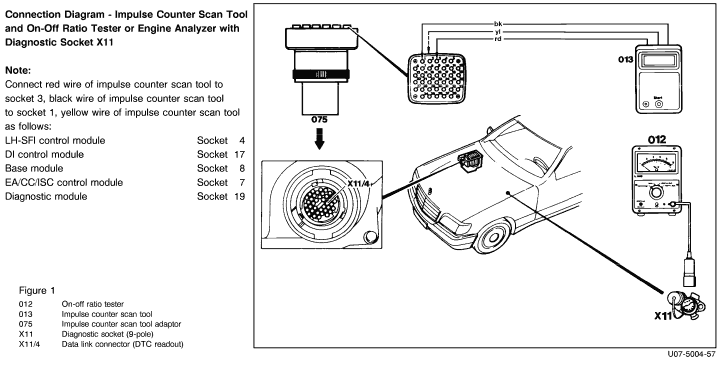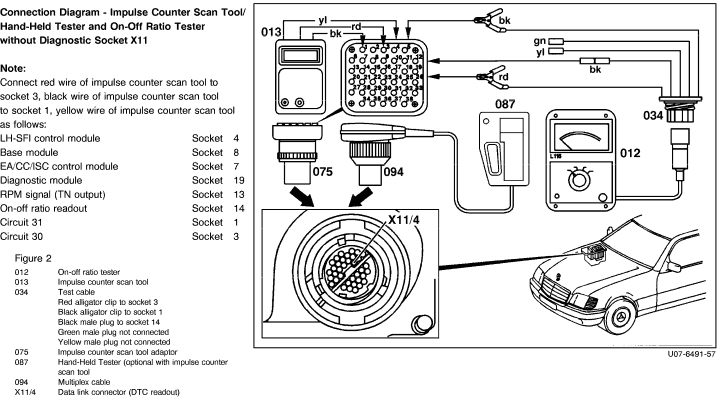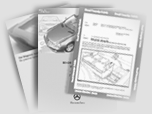Preliminary work: Engine Test and Adjustment, Engines, Volume 1
On-Off Ratio Test
The on-off ratio tests the operation of the O2S (Lambda) control system and additionally, recognizes certain malfunctions present during the test. Malfunctions are distinguished between those that occur with the
Ignition: ON and those that occur with the Engine: at CTP (idle).
The on-off ratio can be checked with the on-off ratio tester or with the engine analyzer. For this purpose, the purge line to the engine must be disconnected at the purge control valve and closed with a plug. Check on-off ratio at closed throttle speed and at 2500 rpm. A readout of 50% or an oscillating needle indicates that all input signals and the O2S control system are OK. Readouts of 10% to 90% or 95% refer to a particular malfunction source (see Malfunction Tables). In addition, after testing the on-off ratio, an impulse readout must be performed using the impulse counter scan tool.
Diagnostic Trouble Code (DTC) Readout with Impulse Counter Scan Tool.
Malfunctions which occur while starting or with the engine running are recorded by a malfunction counter. Malfunctions are assigned a specific value according to malfunction severity (e.g. hot wire MAF sensor 128, ECT sensor 32). The malfunction counter counts in stages up to a threshold value of 255. After reaching the threshold value of 128, intermittent malfunctions are stored into memory after switching off the ignition. Malfunctions which affect engine operation (  128) are immediately stored into DTC memory by the malfunction counter after switching off the ignition. 128) are immediately stored into DTC memory by the malfunction counter after switching off the ignition.
If a malfunction is no longer present during a subsequent engine start or engine operation, the total value recorded by the malfunction counter is reduced by 1 every time the engine is switched off. This procedure repeats itself until the malfunction counter is cleared.
Stored malfunctions (DTC's) can be read with the impulse counter scan tool at the data link connector (X11/4). (Also see DM, Engines, Volume 2, section 5.)

The DTC memory readout must be performed with the engine OFF and the ignition switched ON.
Malfunctions occurring in the following areas are stored immediately:
 CMP sensor, CMP sensor,
 Hot-wire MAF sensor, Hot-wire MAF sensor,
 Injectors. Injectors.
A malfunction of the following is stored after more than 2 trips:
 TN-signal (input). TN-signal (input).
The memory remains active even if the vehicle's battery is disconnected.
DTC's can be read with the impulse counter scan tool. Numbers ranging from 1 to 32 may appear on the display of the impulse counter scan tool.
The number 1 indicates: No DTC recognized in system.
All further numbers refer to a particular malfunction source. If there are multiple system malfunctions, the malfunction assigned with the lowest number will be displayed first.
If the DTC number indicated first reappears after more than two DTC readouts, then no further malfunctions are stored in the system's memory. After eliminating all malfunctions, they must be cleared individually and the ignition must be switched off for a minimum of 15 seconds.
In case of engine running complaints, the DTC memory must be read and the malfunction must be eliminated before proceeding with any additional repairs.
LH-SFI Control Module Self-Adaptation Feature
A self-adaptation feature for the emission control system is incorporated into the LH-SFI control module.
If malfunctions of the:
 Hot-wire MAF sensor, Hot-wire MAF sensor,
 Injectors, Injectors,
 Purge control valve, Purge control valve,
 Diaphragm pressure regulator, Diaphragm pressure regulator,
 Purge valve Purge valve
occur or if intake air leaks are present, the LH-SFI control module conducts a self-adaptation process whereby the correction factors are continuously calculated and permanently stored.
After eliminating the mentioned malfunctions or after trial installation of a LH-SFI control module from another vehicle, the LH-SFI control module's self-adaptation feature must be reset to its mean value (see "Resetting LH-SFI Control Module's Self-Adaptation Feature to Mean Value"  11 /4 or with HHT menu selection 5 "Self-Adaptation"). 11 /4 or with HHT menu selection 5 "Self-Adaptation").
The LH-SFI control module will also adapt itself during the course of vehicle operation.
Notes for HHT
 Fault search with HHT. Fault search with HHT.
Diagnostic trouble code (DTC) memory: Select "Current DTC's".
If the actual condition changes, e.g. when wiggling a connector, the change is reported optically and acoustically so that troubleshooting can be performed directly with the HHT.
 Loose connections. Loose connections.
Loose connections are stored if they occur several times in a certain time period. Therefore, they can appear only as "Stored DTC's" and never as "Current DTC's".
 Nominal values. Nominal values.
All nominal values relative to the actual values as shown on the HHT are listed in the DM, Engines, Volume 1, section A.
 Actual values for ECT, IAT and MAF. Actual values for ECT, IAT and MAF.
In case of an open or short circuit, the actual value is immediately replaced by a substitute value which is very close to the actual value. Therefore, a fault can not be recognized clearly. A readout of the fault is possible only via the diagnostic trouble code (DTC) memory.
 Actual value for engine rpm. Actual value for engine rpm.
In case of the engine rpm's, the HHT display shows the closed throttle (idle) speed nominal value calculated by the control module on the left, and on the right, the rpm actual value. Both values should differ from each other only slightly. The permissible tolerances are not known.
Preparation for Test with Impulse Counter Scan Tool
 Connect impulse counter scan tool and on-off ratio tester according to connection diagram. Connect impulse counter scan tool and on-off ratio tester according to connection diagram.
 Reading Diagnostic Trouble Code (DTC) Memory Reading Diagnostic Trouble Code (DTC) Memory
a) Ignition: ON
b) Press start button for 2 to 4 seconds.
c) Read and record DTC readout.
d) Press start button again for 2 to 4 seconds.
e) Read and record DTC readout.
Repeat steps d) and e) until the first DTC reappears.
Clearing Diagnostic Trouble Code (DTC) Memory
a) Press start button for 2 to 4 seconds (DTC readout appears).
b) Wait 3 seconds, press start button for 6 to 8 seconds, thereby clearing the previously displayed DTC from memory.
c) Each stored DTC must be cleared individually.
d) Ignition: OFF and wait 15 seconds.
Check if all stored DTC's are eliminated.
e) Ignition: ON
f) Repeat DTC readout. The number " 1 " (no DTC stored) must appear.
Resetting LH-SFI Control Module's Self-Adaptation Feature to Mean Value
After the number " 1 " appears on the display, press start button for 6 to 8 seconds.
Ignition: OFF and wait 30 seconds. |
 |
 |
 |
 |
| a) On-Off Ratio Test, Ignition: ON |
| On-Off Ratio % |
Possible cause |
Test step/Remedy 1) |
| 0 |
Voltage supply from socket 3 of data link connector (X11/4) open circuit |
Repair harness |
| 1 0 |
CTP (idle) recognition inactive |
 23 23  15.0 15.0 |
| 2 0 |
WOT (full load) recognition active |
 23 23  15.0 15.0 |
| 3 0 |
Engine coolant temperature < 70 oC or >110 oC |
 23 23  9.0 , 10.0 9.0 , 10.0 |
| 4 0 |
Not used |
|
| 5 0 |
Input signals OK |
|
| 6 0 |
TN-signal (rpm signal) or CMP sensor signal not present while starting |
 23 23  12.0 - 14.0 12.0 - 14.0 |
| 7 0 |
Starter engaged |
 23 23  8.1 8.1 |
| 8 0 |
CAN-data exchange defective |
 23 23  39.0 39.0 |
| 9 0 |
Fuel safety shut-off active |
Check CC/ISC (see DM, Engines, Volume 3, Section 7.1)
or
Check EA (see DM, Engines,
Volume 3, Section 6.2) |
1) Observe Preparation for Test, see  22 . 22 . |
| b) On-Off Ratio Test, Engine: at CTP (idle) |
| On-Off Ratio % |
Possible cause |
Test step/Remedy 1) |
| 0 |
Short circuit to battery + in wire to data link connector (X11/4), socket 3 |
Repair harness |
| 1 0 |
CTP (idle) recognition applied constantly |
 23 23  15.0 15.0 |
| 2 0 |
Output of fuel injectors or
one or more fuel injectors have open circuit |
 23 23  32.0 , 33.0 32.0 , 33.0 |
| 3 0 |
ECT sensor (B11/2) |
 23 23  9.0 , 10.1 9.0 , 10.1 |
| 4 0 |
Hot wire MAF sensor (B2/2) |
 23 23  5.0 , 6.0 5.0 , 6.0 |
| 5 0 2) |
O2S 1 (before TWC) (G3/2) not operational or defective, open circuit |
 23 23  18.0 - 19.1 18.0 - 19.1 |
| 6 0 |
CMP sensor (L5/1) |
 23 23  14.0 14.0 |
| 7 0 |
TN-signal (rpm signal) |
 23 23  12.0 , 13.0 12.0 , 13.0 |
| 8 0 |
CAN-data exchange defective |
 23 23  39.0 - 40.0 39.0 - 40.0
Either EA/CC/ISC control module, CC/ISC control module or DI control module not transmitting. |
| 9 0 |
Vehicle speed signal (VSS) |
Check CC/ISC (see DM, Engines, Volume 3, section 7.1)
or
Check EA (see DM, Engines,
Volume 3, section 6.2) |
| 9 5 |
Deceleration shut-off active |
Check CC/ISC (see DM, Engines, Volume 3, section 7.1)
or
Check EA (see DM, Engines,
Volume 3, section 6.2) |
| 1 0 0 |
No voltage at LH-SFI control module (N3/1) |
 23 23  1.0 - 3.0 1.0 - 3.0 |
1) Observe Preparation for Test, see  22 . 22 .
2) Needle oscillates if all monitored signals are OK. |
c) LH-SFI Control Module DTC Readout
DTC
  |
Possible cause |
Test step/Remedy 1) |
| 1 |
No malfunction in system |
- |
| 2 |
ECT sensor (B11/2) sensor circuit 1, open/short circuit |
 23 23  9.0 9.0 |
| 3 |
ECT sensor (B11/2) sensor circuit 2, open/short circuit |
 23 23  10.0 10.0 |
| 4 2) |
Voltage at hot wire MAF sensor (B2/2) insufficient or too high, or open circuit in ground wire at hot wire MAF sensor |
 23 23  5.0 - 6.0 5.0 - 6.0 |
| 5 |
Not used |
- |
| 6 |
Not used |
- |
| 7 |
TN-signal (rpm signal) incorrect or open/short circuit |
 23 23  12.0 12.0 |
| 8 |
CMP sensor (L5/1) signal, open/short circuit |
 23 23  14.0 14.0 |
| 9 |
Starter signal (circuit 50) missing, open/short circuit |
 23 23  8.1 8.1 |
| 1 0 3) |
CTP (idle) recognition from EA/CC/ISC control module (N4/1) or CC/ISC control module (N4/3), short circuit |
 23 23  15.0 15.0 |
| 1 1 4) |
Secondary air injection system, open/short circuit |
 23 23  23.0 23.0 |
| 1 2 |
Burn-off control for hot wire MAF sensor, open/short circuit |
 23 23  7.0 7.0 |
| 1 3 |
IAT sensor (B17/7), open/short circuit |
 23 23  11.0 11.0 |
| 1 4 |
Not used |
- |
| 1 5 |
Not used |
- |
| 1 6 5) |
EGR switchover valve (Y27), open/short circuit |
 23 23  20.0 20.0 |
| 1 7 7) |
No CAN data transmission with EA/CC/ISC control module (N4/1) or
CC/ISC control module (N4/3) |
 23 23  39.0 39.0
or N4/1
or N4/3. |
| 1 8 6) |
No CAN data transmission with DI control module (N1/3) |
 23 23  39.0 39.0
or N1/3. |
| 1 9 |
Not used |
- |
| 2 0 |
No CAN data transmission from LH-SFI control module (N3/1) |
 23 23  40.0 40.0 |
| 2 1 |
O2S 1 (before TWC) (G3/2), open/short circuit |
 23 23  18.0 18.0 |
| 2 2 |
O2S 1 heater, open/short circuit |
 23 23  19.0 19.0 |
| 2 3 |
Purge control valve (Y58/1), open/short circuit |
 23 23  24.0 24.0 |
| 2 4 (Engine 119 only) |
Left adjustable camshaft timing solenoid (Y49/1), open/short circuit |
 23 23  27.0 27.0 |
| 2 5 |
Adjustable camshaft timing solenoid, engine 104 (Y49) or right adjustable timing solenoid, engine 119 (Y49/2), open/short circuit |
 23 23  26.0 26.0 |
| 2 6 |
Upshift delay switchover valve (Y3/3), open/short circuit |
 23 23  34.0 34.0 |
| 2 7 |
Injectors (Y62), open/short circuit |
 23 23  32.0 32.0 |
| 2 8 |
LH-SFI control module coding, open circuit |
 23 23  43.0 43.0 |
| 2 9 (Model 124.034 only) |
1GR start relay module (K29/1), open/short circuit |
 23 23  44.0 44.0 |
1) Observe Preparation for Test, see  22 . 22 .
2) DTC 4 can be displayed on vehicles up to 7/91 even if no fault is present.
3) DTC 1 0 can be displayed on vehicles up to 7/91 even if no fault is present.
4) DTC 1 1 can be displayed on vehicles up to 7/91 even if no fault is present.
5) DTC 1 6 can be displayed on vehicles up to 7/91 even if no fault is present.
6) DTC 1 8 can be displayed on vehicles up to 7/91 even if no fault is present.
7) DTC 1 7 can be displayed even if no fault is present. |
|


 Printable version
Printable version


 Printable version
Printable version